| Columns Retired Columns & Blogs |
Sony SS-NA2ES loudspeaker Measurements
Sidebar 3: Measurements
Footnote 1: When I did some preliminary measurements of the first pair of SS-NA2ESes before blowing out the tweeters, the mid-treble depression was less pronounced than with this second, replacement pair.—John Atkinson
I used DRA Labs' MLSSA system and a calibrated DPA 4006 microphone to measure the Sony SS-NA2ES's frequency response in the farfield, and an Earthworks QTC-40 for the nearfield and spatially averaged room responses. All the measurements were performed with the second pair of SS-NA2ES speakers.
My estimate of the SS-NA2ES's voltage sensitivity was 91dB(B)/2.83V/m, a full dB higher than the specified 90dB. As I found in my auditioning, this is a high-sensitivity speaker. The Sony's impedance magnitude drops below 4 ohms in the midrange and high treble (fig.1), reaching minimum values of 3.52 ohms at 340Hz and 3.56 ohms at 7.9kHz, meaning that the speaker is actually drawing 2W or more to reach that 91dB figure with 2.83V drive. But while there is a combination of 5 ohms magnitude and –55° electrical phase angle at 81Hz, a good 4 ohm–rated amplifier will have no problems driving the 'NA2ES.
The traces in fig.1 are free from the small discontinuities that hint at the presence of vibration resonances of some kind. However, examining the behavior of the enclosure's panels with a simple plastic-tape accelerometer, I found a cluster of resonances on the sidewalls, at 383, 477, 578, and 619Hz (fig.2). Still, even the mode highest in level, at 691Hz, is low in absolute terms; it's likely that these resonances are too high in frequency and too low in level to have any adverse effect on the speaker's midrange clarity.
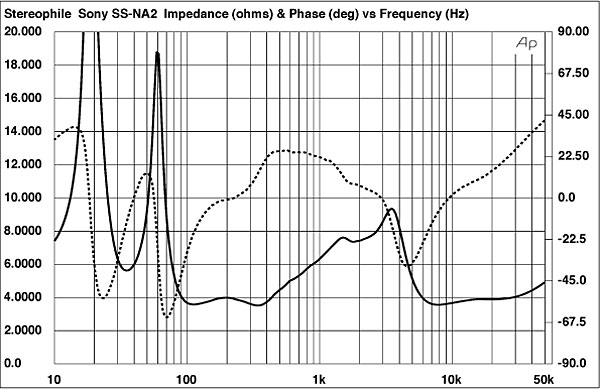
Fig.1 Sony SS-NA2ES, electrical impedance (solid) and phase (dashed) (2 ohms/vertical div.).
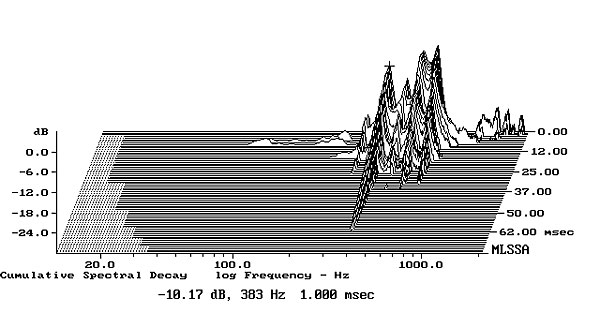
Fig.2 Sony SS-NA2ES, cumulative spectral-decay plot calculated from output of accelerometer fastened to center of side panel level with midpoint of woofers (MLS driving voltage to speaker, 7.55V; measurement bandwidth, 2kHz).
The saddle between 30 and 40Hz in the impedance-magnitude trace (fig.1, solid trace) suggests that the lower port on the SS-NA2ES's rear panel is tuned to a frequency in this region. However, the combined output of the two woofers, measured in the nearfield (fig.3, blue trace), has its minimum-motion notch (ie, where the back pressure from the port resonance holds the woofer cones still) a little higher in frequency, at 40Hz. The port itself (red) covers quite a broad (25–75Hz) bandpass, with a commendably well-controlled upper-frequency rolloff. The woofers behave identically below 300Hz, but the lower woofer appears to roll off a little earlier than the upper. I haven't shown in fig.3 the nearfield response of the upper port, which loads the midrange unit, as that output is very low in level. As with Sony's SS-AR2 and the Wilson designs, the function of that port is not to extend the drive-unit's low-frequency response, but more to improve its linearity at the bottom of its passband. The 'NA2ES's midrange driver (green trace) appears from this graph to cross over to the woofers a little lower than the specified 400Hz, with initially a gentle high-pass slope. The farfield response on the central tweeter axis in the midrange and above is basically flat, but with a broad depression in the mid-treble1 balanced by a slight excess of energy above that region. The response extends smoothly at full level to the 30kHz upper limit of this graph.
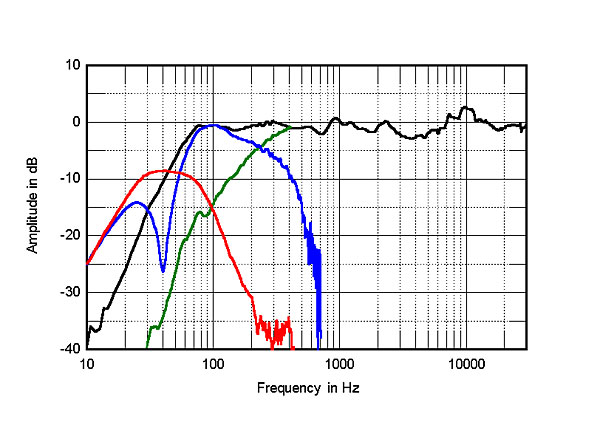
Fig.3 Sony SS-NA2ES, anechoic response on central HF axis at 50", averaged across 30° horizontal window and corrected for microphone response, with nearfield responses of woofer (blue) and port (red) and their complex sum (black), respectively plotted below 350Hz, 1kHz, 300Hz.
In general, the plot of the SS-NA2ES's lateral dispersion, referenced to the central tweeter's on-axis response (fig.4) shows that the speaker offers a smooth, well-controlled radiation pattern. Looking more closely at this graph, it looks as if the mid-treble gulley in the on-axis response does fill in a little to the speaker's sides, which will work against any tendency for the speaker to sound too polite. The dispersion above 10kHz, which is where a conventional 1" tweeter starts to get quite directional, is also wide, the Sony's output not dropping off in a major way to the sides until above 16kHz or so. Those small auxiliary tweeters are doing what they are intended to do, widening the speaker's radiation pattern in the top audio octave. In the vertical plane (fig.5), a sharply defined suckout develops at the upper crossover frequency of 4.4kHz at 5° and more above the tweeter axis. The on-axis mid-treble gulley fills in below the tweeter axis, which is 35" from the floor. But despite the top octaves being handled by three drive-units vertically spaced more than a wavelength apart, the vertical dispersion is smooth, even without the 1/10-octave smoothing used to create the traces in the graph.
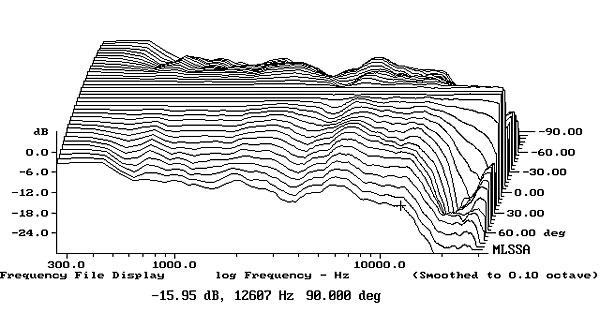
Fig.4 Sony SS-NA2ES, lateral response family at 50", normalized to response on central HF axis, from back to front: differences in response 90–5° off axis, reference response, differences in response 5–90° off axis.
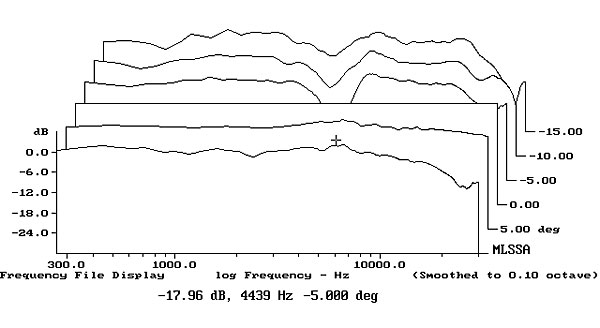
Fig.5 Sony SS-NA2ES, vertical response family at 50", normalized to response on central HF axis, from back to front: differences in response 15–5° above axis, reference response, differences in response 5–10° below axis.
The red trace in fig.6 shows how this quasi-anechoic behavior added up in my listening room. For reference, the blue trace shows the in-room response of the Sony SS-AR2. (Both traces were generated by averaging 20 1/6-octave–smoothed spectra, taken for the left and right speakers individually using SMUGSoftware's FuzzMeasure 3.0 program and a 96kHz sample rate, in a vertical rectangular grid 36" wide by 18" high and centered on the positions of my ears.) The in-room responses of the two Sony speakers are very similar, which is not surprising given that they were designed by the same engineer and that he set up both pairs of speakers in my room.
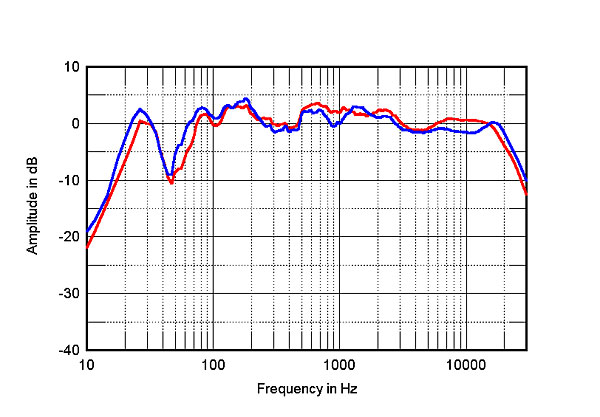
Fig.6 Sony SS-NA2ES, spatially averaged, 1/6-octave response in JA's listening room (red); and of Sony SS-AR2 (blue).
But there are differences in the details. Both speakers benefit from the lowest-frequency room mode, around 32Hz, but the SS-AR2 goes a few Hz deeper than the SS-NA2ES and the low bass is slightly higher in level. The more expensive Sony speaker has a little too much upper-midrange energy in-room, but I had no problems with its top-octave balance. The 'NA2ES also has slightly more energy evident at the top of the midrange, but more significant, the wider dispersion in the top octaves gives rise to an excess of energy in-room above 6kHz. Typically, this kind of in-room response should gently slope down with increasing frequency, due to the increasing absorptivity of the room furnishings at high frequencies. The SS-NA2ES, however, both has a little too much HF energy in absolute terms and more than that offered by the SS-AR2. This behavior, I think, is why I felt the 'NA2ES's treble sounded somewhat wispy and slightly disconnected from the low treble.
Turning to the time domain, the SS-NA2ES's step response on the central HF axis is shown in fig.7. The output of the three tweeters arrives first at the microphone, and reveals that they are connected in inverted acoustic polarity. The decay of the tweeters' step blends smoothly with the rise of the midrange unit's step, this drive-unit also connected in inverted acoustic polarity. The decay of the midrange step blends smoothly with the rise of the woofers' step, these drivers connected in positive polarity. I confirmed all of these polarities by looking at the individual step responses (not shown); the smooth blending of the steps suggests optimal crossover design. Though the farfield cumulative spectral-decay plot (fig.8) is impressively clean overall, some slight hash is visible at the bottom of the tweeters' passband, this most likely due to midrange-cone problems that have not been fully suppressed by the crossover.
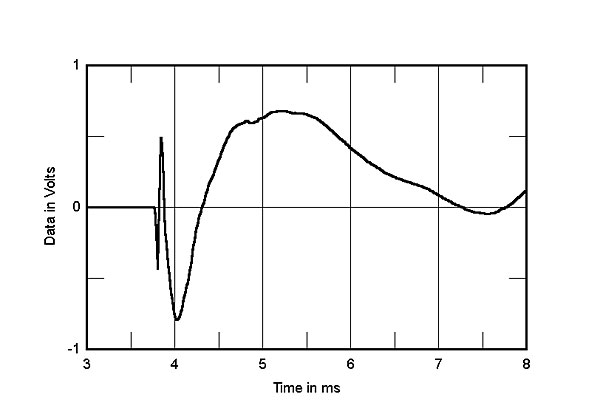
Fig.7 Sony SS-NA2ES, step response on central HF axis at 50" (5ms time window, 30kHz bandwidth).
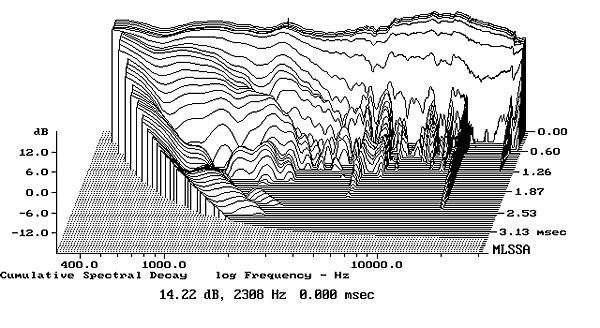
Fig.8 Sony SS-NA2ES, cumulative spectral-decay plot on central HF axis at 50" (0.15ms risetime).
Sony's SS-NA2ES offers the excellent measured performance I have come to expect from its designer.—John Atkinson
Footnote 1: When I did some preliminary measurements of the first pair of SS-NA2ESes before blowing out the tweeters, the mid-treble depression was less pronounced than with this second, replacement pair.—John Atkinson
- Log in or register to post comments




































